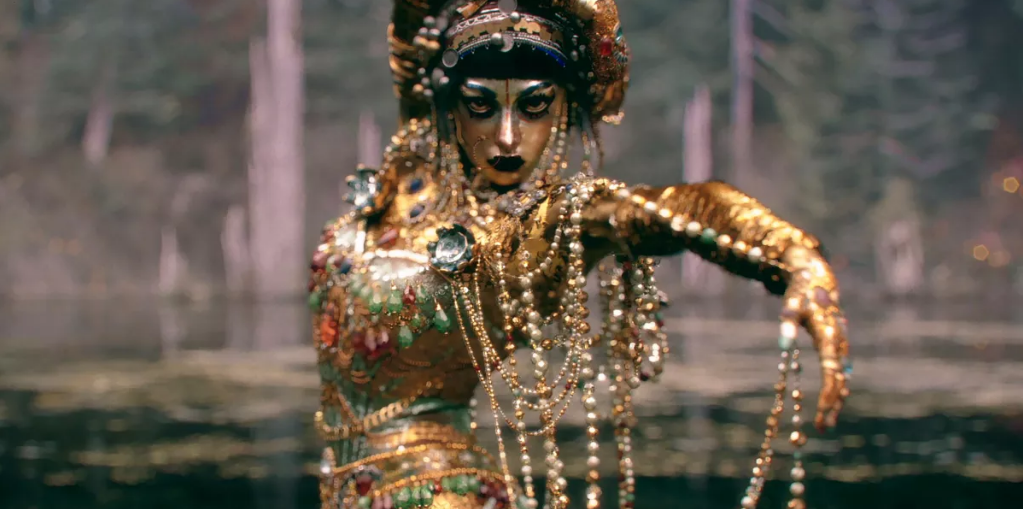"Jibaro” makes me wonder if we should listen more closely to the call of Sirens. This 17 minute long, Love Death Robots episode has me asking if the intent of such creatures of folklore is truly malicious. Have we...
By Savannah Mandel
“Jibaro” makes me wonder if we should listen more closely to the call of Sirens. This 17 minute long, Love Death Robots episode has me asking if the intent of such creatures of folklore is truly malicious. Have we been championing a different evil all along? Are there not wicked motives shifting beneath the surface of those sailors and knights who pillage all that is gold and shimmering from the bodies of the powerful creatures they capture?
I’m speaking to the plot of the short episode, which touches on the brutality of a toxic, erotic, relationship through the dance of a siren and a deaf knight as they slowly destroy each other through their mating.
 The Siren’s Dance CR: NETFLIX
The Siren’s Dance CR: NETFLIX
Jibaro – named for the male protagonist of the film, the deaf knight – begins with the crossing of a cavalry through a forest situated near marshland and rapids. (1) The company’s armor is as gilded as the siren they will soon meet. Their mounts are draped in silk signs of avarice and soon they reach the sweeping edge of a lake. It’s bottom – and the secrets it holds – are deep and dark.
At the lake’s edge, an exchange occurs. Audience members observe a sect of priests approach the knights, and a swift swearing of fealty–a remnant of colonial history, echoing chivalric, religiously-bound, “civilizing missions.” These missions, typical across the histories of dominant nations, were often extractivist and colonial in nature, but justified through moral or religious belief systems (Adas and Cagle, 2012; Adas, 2006).
 The Knight CR: NETFLIX
The Knight CR: NETFLIX
Then, the knights’ mission turns extractivist, as our male protagonist finds a piece of gold in the lake bed. As he plucks this gold from its watery grave (and grave, indeed it is, because unbeknownst to him it is surrounded by bones) the Siren begins her dance.
Her dance, in its turbulent beauty, draws all members of the cavalry (but one) to drown under the weight of the pillaged gold hanging from their sigiled suits. Only the knight is saved by the fact that he cannot hear the Siren’s song.
This is where one might demonize our story’s water demon, for luring unwary armored men to their watery deaths. But, as Jibaro’s tale unfolds, an unbalanced duality of violence reveals itself, reverberating those echoes of imperialism through metaphors of rape, leading me to question why the blame tends to fall on the creatures of lore and not their violent white knights.
The deaf knight survives the Siren’s lethal song, and joins her in a mutual erotic dance. In fact, she is the first to pursue him, attracted by his strange resistance to her lethal melody. But their mating quickly turns malignant as greed overcomes the Knight. Captivated by the gold scales covering her body, and even the rubies coating her lips, Jibaro knocks the Siren unconscious by slamming her head against a rock repeatedly and plucks all that is valuable from her in an act cinematically filmed to mimic sexual violence. In a way, his extraction of the literal gemstones from her body is sexual violence, because the act leaves the Siren disrobed against her will.
 The Siren post-assault. CR: NETFLIX
The Siren post-assault. CR: NETFLIXSuch extractionist violence also echoes the painful and brutal legacies of global colonialism which so often have left indigenous populations vulnerable and defenseless. Which is why it is surprising to me that other authors have argued that the Knight’s act of violence against the Siren was not unbalanced, in other words, that the Siren was not a victim, but instead, was blame for the events which occurred (Tallarita, 2022). Andrea Tallarita wrote for PopMatters that Jibaro should also not be viewed as a metaphor for colonialism for several reasons, many of which I find problematic. Tallarita argued that the knight should be viewed as “less powerful” than the Siren because of his hearing disability (as someone who recently taught a course on Technology and Disability I find this pretty ableist. You can be big and strong while having a hearing disability, thank you very much). Tallarita also argues that based on historic Spanish readings of traditional Chivalric literature the knights should be considered not as imperialist, but heroic, and the Siren as a treasure herself – to be claimed, that the act of claiming her is unproblematic (Tallarita, 2022).
I myself have become increasingly sympathetic to our darling monstress, now claimed – her body stripped bare of its value and tossed into the churning rapids by the knight. Left for dead. And I personally see beauty, in the strokes of the Siren’s lethal dance, when she rises from the dead and seeks revenge against the man who saw her body as a mere object to be stripped for goods. I found myself sitting on the edge of my seat wishing she would pour gold into those knight’s sabatons, to weigh them down to the lake bottom even faster.
To reason with a Siren… the prospect seems impossible, doesn’t it? After all, isn’t she just another savage monster? An sexualized, glittering object of the orient?
But let us not forget that early colonizers thought it was impossible to reason with indigenous populations, and they threw that s-word around long after their colonies were established (Knauft, 2018; Boas, 1911; Malinowksi, 1929).
It should not be denied that the Knight and the Siren’s story is a sad one. Mielgo, their creator, isn’t wrong, when he said in an interview that they revealed the worst of themselves to each other (Davis, 2022). But if we consider this Siren an embodied metaphor for indigenous populations, and our deaf knight and his fellow conquistadors as a metaphor for actual conquistadors and other iterations of colonizers, perhaps the Siren’s defensive, self-preservationist instinct becomes something easier to understand. After all, the episode offers hints early on that these men were not the only trespassers to encroach upon her land.
 A fan-created poster for “Jibaro” by artist Artem Pavlov. @digital.pavlov
A fan-created poster for “Jibaro” by artist Artem Pavlov. @digital.pavlov
Like many other female monsters of myth and folklore, the Siren of Mielgo’s story was first a victim. Other historic female monstresses, such as Medusa have become so notorious for the anguish they faced prior to taking their final form that now modern tattoos of them take on special symbolism (Katee, 2022).
This Love Death Robots episode is not just another allegory of colonial and extractivist intent (and yes, let’s be clear I am arguing that it is). It is also a reminder that in the present day, the objectification, the demonizing, the Orientalism, the othering, of the female form occurs as a form of colonialism. Authors continue to argue that the Sirens are a treasure to be claimed by foreign knights who seek to rip gemstones from their bodies (Tallarita, 2022).
This metaphor of sexual violence can be extended to legacies of colonialism, harmful to the real indigenous populations still facing the damage of extractivism, or it can be left at the limits of a feminist reading. Each speaks to different truths.
As I conclude this requiem through science fiction, I do want to emphasize that this is not a bad review.
It’s an exaltation.
Jibaro was, in my opinion, a masterpiece. And Mielgo an artist. But, he really should have named that episode after the Siren, rather than her rapist.
Notes
(1) Mielgo explained in an interview that Jibaro, which translates to the inhabitants of a small region of Puerto Rico or a manual laborer, is also the name of the main male protagonist of the episode.
Works Cited
Adas, Michael and Hugh Glenn Cagle. “Age of Settlement and Colonisation.” in the Ashgate Research Companion to Modern Imperial Histories, eds. John Marriot and Phillipa Levine. Milton Park: Routledge, 2012.
Adas, Michael. Dominance by Design: Technological Imperatives and America’s Civilizing Mission. Cambridge: Harvard University Press, 2006.
Boas, Franz. The Mind of Primitive Man. New York: MacMillian, [1938], 1911.
Davis, Victoria. “Alberto Mielgo Tells a Toxic Tale of Sensuality in ‘Love, Death + Robots’ Volume 3.” May 20, 2022 https://www.awn.com/animationworld/alberto-mielgo-tells-toxic-tale-sensuality-love-death-robots-volume-3.
Katee, Annita. “I’m a Tattoo Artist, and Here’s What You Need To Know About the Very Special Medusa Tattoo’.” November 27, 2022 https://www.wellandgood.com/medusa-tattoomeaning/#:~:text=What%20does%20the%20Medusa%20tattoo,level%2C%20particularly%20by%20men.%E2%80%9D.
Knauft, Bruce. “From Savage to Good: A Brief Genelogy of Anthropology By Route of the Primitive, the Dark, and the Suffering Subject.” AAA meetings, San Jose, CA, November 17, 2018.
Neill, Deborah. “Science and Civilizing Missions: Germans and the Transnational Community of Tropical Medicine.” in German Colonialism in a Global Age, edited by Bradley Naranch and Geoff Eley. Duke University Press, 2015.
Neill, Deborah. Networks in Tropical Medicine: Internationalism, Colonialism, and the Rise of a Medical Specialty, 1890–1930. Stanford University Press, 2012.
Malinowski, Bronislaw. The Sexual Life of the Savages in Northwest Melanesia. New York: Kessinger Publishing, [2005] 1929.
Tallarita, Andrea. “Alberto Mielgo’s Sci-Fi Short ‘Jibaro’ is Not A Critique of Colonialism.” PopMatters, June 1, 2022 https://www.popmatters.com/alberto-mielgo-jibaro-sci-fi.















